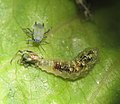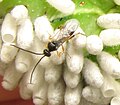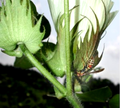Biological pest control
(Redirected from Biocontrol)
Biological pest control is a method of controlling pests such as insects, mites, weeds and plant diseases using other organisms. It relies on predation, parasitism, herbivory, or other natural mechanisms, but typically also involves an active human management role. It can be an important component of integrated pest management (IPM) programs.
Introduction
Biological control involves the use of living organisms to reduce or eliminate populations of unwanted pests, thereby reducing the need for chemical pesticides. The organisms used in biological control, known as biological control agents, include predators, parasitoids, and pathogens that attack insect pests and weeds.
Types of Biological Control Agents
Predators
Predators are organisms that hunt, kill, and consume their prey. Examples include lady beetles and lacewings which consume aphids, and spiders that prey on various insect pests.
Parasitoids
Parasitoids are insects that lay their eggs on or in the body of an insect host, which is then used as a food source for the developing larvae. The host is eventually killed. Common examples include certain species of wasps and flies.
Pathogens
Pathogens are disease-causing organisms including bacteria, viruses, and fungi that infect and kill pests. For example, Bacillus thuringiensis, a bacterium, produces toxins lethal to certain insects.
Weed Control
Biological weed control involves the use of specific insects, mites, or other organisms to combat invasive weeds. For instance, the release of specific beetles to control purple loosestrife has been successful in some areas.
Advantages and Disadvantages
Advantages
Biological pest control is environmentally friendly, reducing the use of chemical pesticides and the associated risks to human health and the environment. It can provide a long-term solution to pest problems by establishing a balance between pest and predator populations.
Disadvantages
There are also challenges, including the potential for the control agents to become invasive species themselves, difficulty in maintaining the balance between pest and predator populations, and the slower action of biological methods compared to chemical pesticides.
Applications
Biological pest control is used in agriculture, horticulture, forestry, and urban pest management. It can be particularly effective in greenhouses and in integrated pest management systems where chemical use is minimized.
Future Directions
Research continues into improving the efficacy and range of biological control methods. This includes genetic modification of control agents to enhance their effectiveness and the development of new techniques for mass rearing and distribution of these organisms.
See Also
Transform your life with W8MD's budget GLP-1 injections from $125.
W8MD offers a medical weight loss program to lose weight in Philadelphia. Our physician-supervised medical weight loss provides:
- Most insurances accepted or discounted self-pay rates. We will obtain insurance prior authorizations if needed.
- Generic GLP1 weight loss injections from $125 for the starting dose.
- Also offer prescription weight loss medications including Phentermine, Qsymia, Diethylpropion, Contrave etc.
NYC weight loss doctor appointments
Start your NYC weight loss journey today at our NYC medical weight loss and Philadelphia medical weight loss clinics.
- Call 718-946-5500 to lose weight in NYC or for medical weight loss in Philadelphia 215-676-2334.
- Tags:NYC medical weight loss, Philadelphia lose weight Zepbound NYC, Budget GLP1 weight loss injections, Wegovy Philadelphia, Wegovy NYC, Philadelphia medical weight loss, Brookly weight loss and Wegovy NYC
|
WikiMD's Wellness Encyclopedia |
| Let Food Be Thy Medicine Medicine Thy Food - Hippocrates |
Medical Disclaimer: WikiMD is not a substitute for professional medical advice. The information on WikiMD is provided as an information resource only, may be incorrect, outdated or misleading, and is not to be used or relied on for any diagnostic or treatment purposes. Please consult your health care provider before making any healthcare decisions or for guidance about a specific medical condition. WikiMD expressly disclaims responsibility, and shall have no liability, for any damages, loss, injury, or liability whatsoever suffered as a result of your reliance on the information contained in this site. By visiting this site you agree to the foregoing terms and conditions, which may from time to time be changed or supplemented by WikiMD. If you do not agree to the foregoing terms and conditions, you should not enter or use this site. See full disclaimer.
Credits:Most images are courtesy of Wikimedia commons, and templates, categories Wikipedia, licensed under CC BY SA or similar.
Contributors: Prab R. Tumpati, MD












